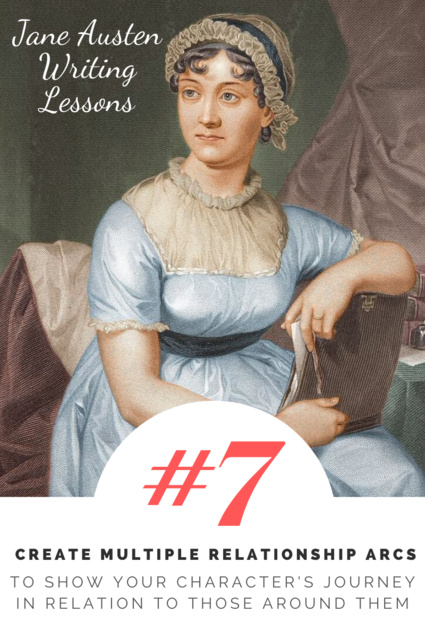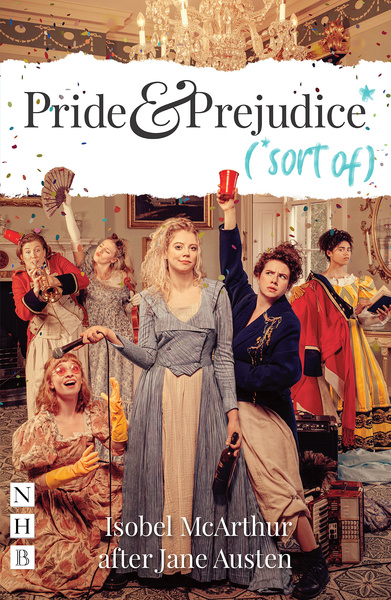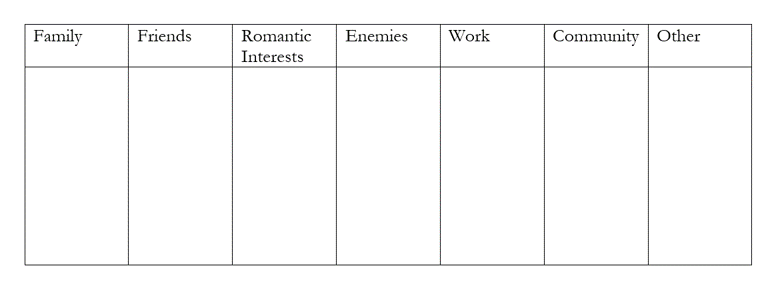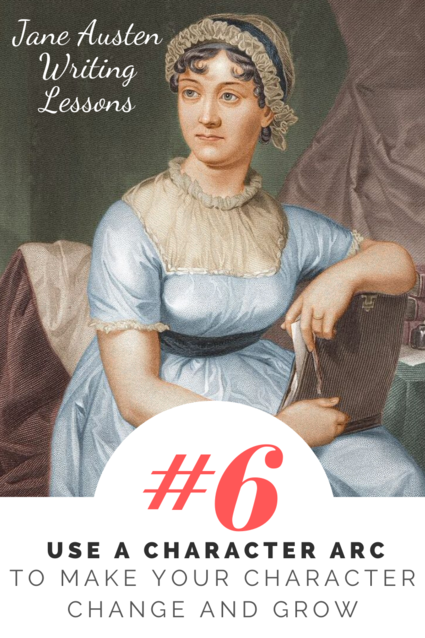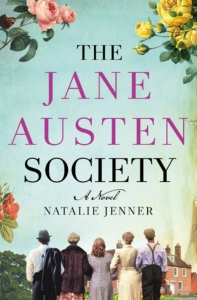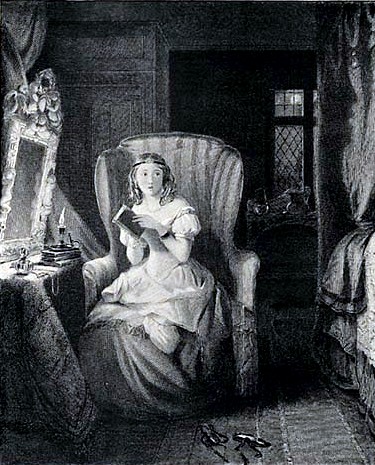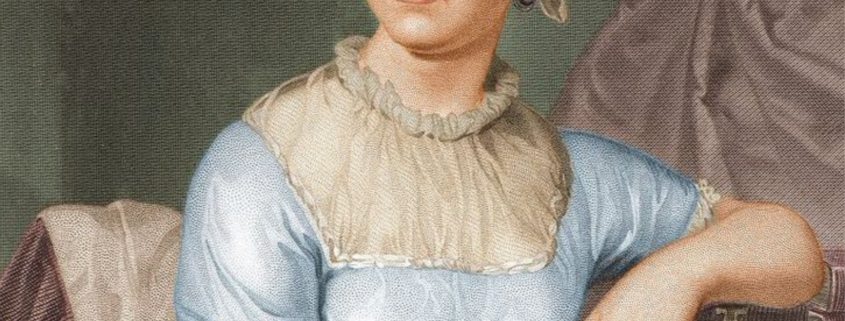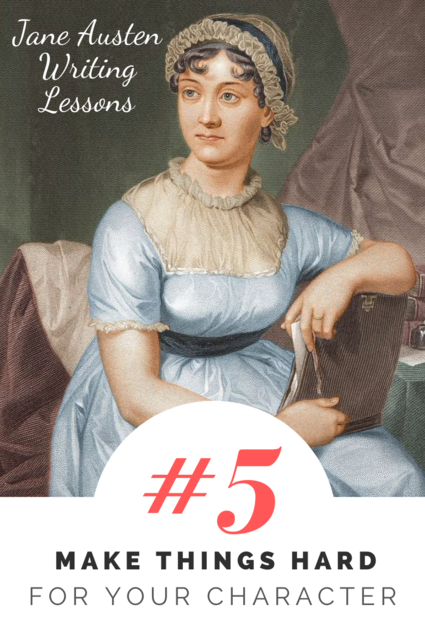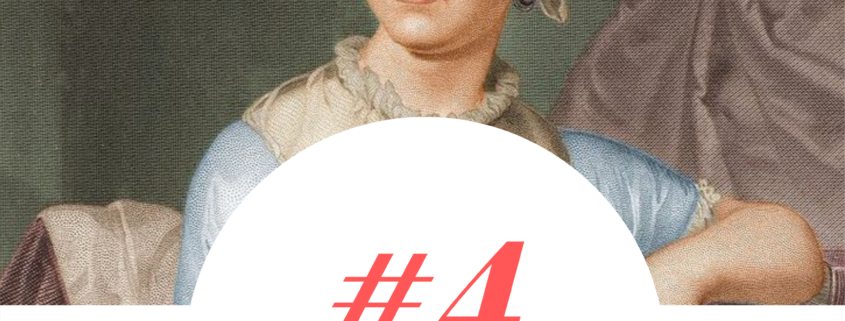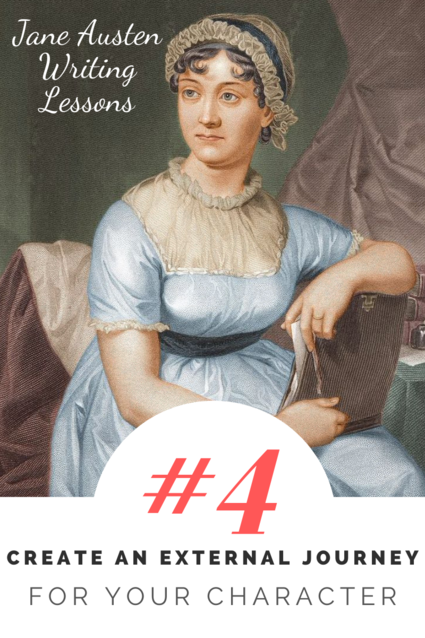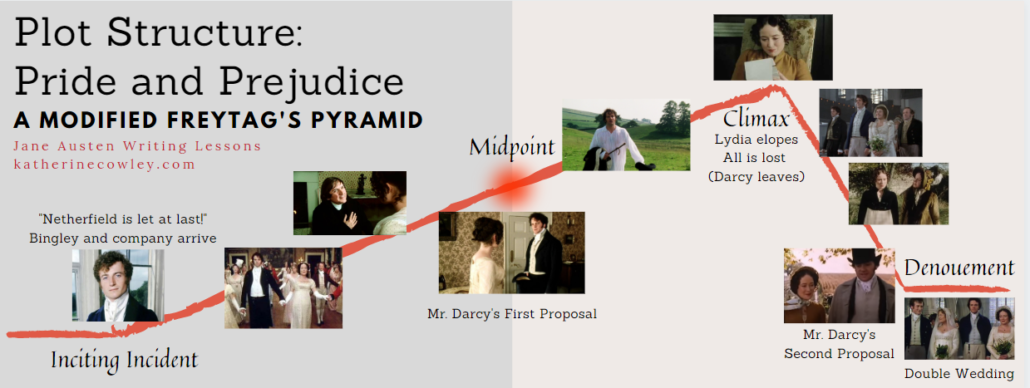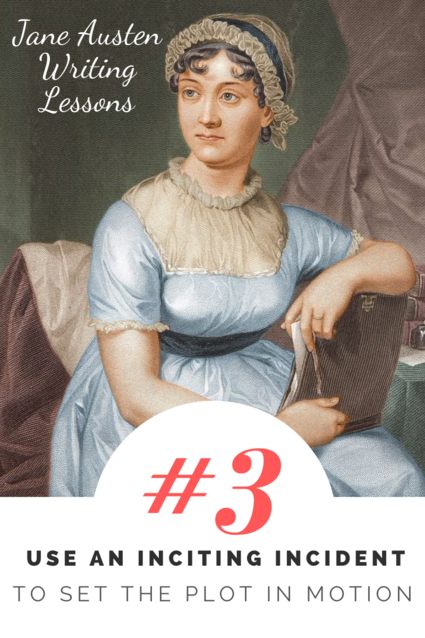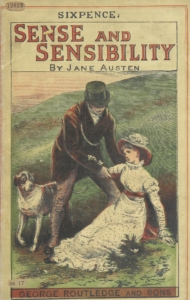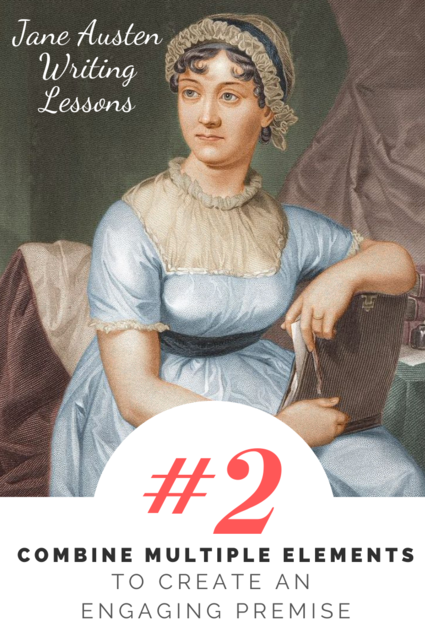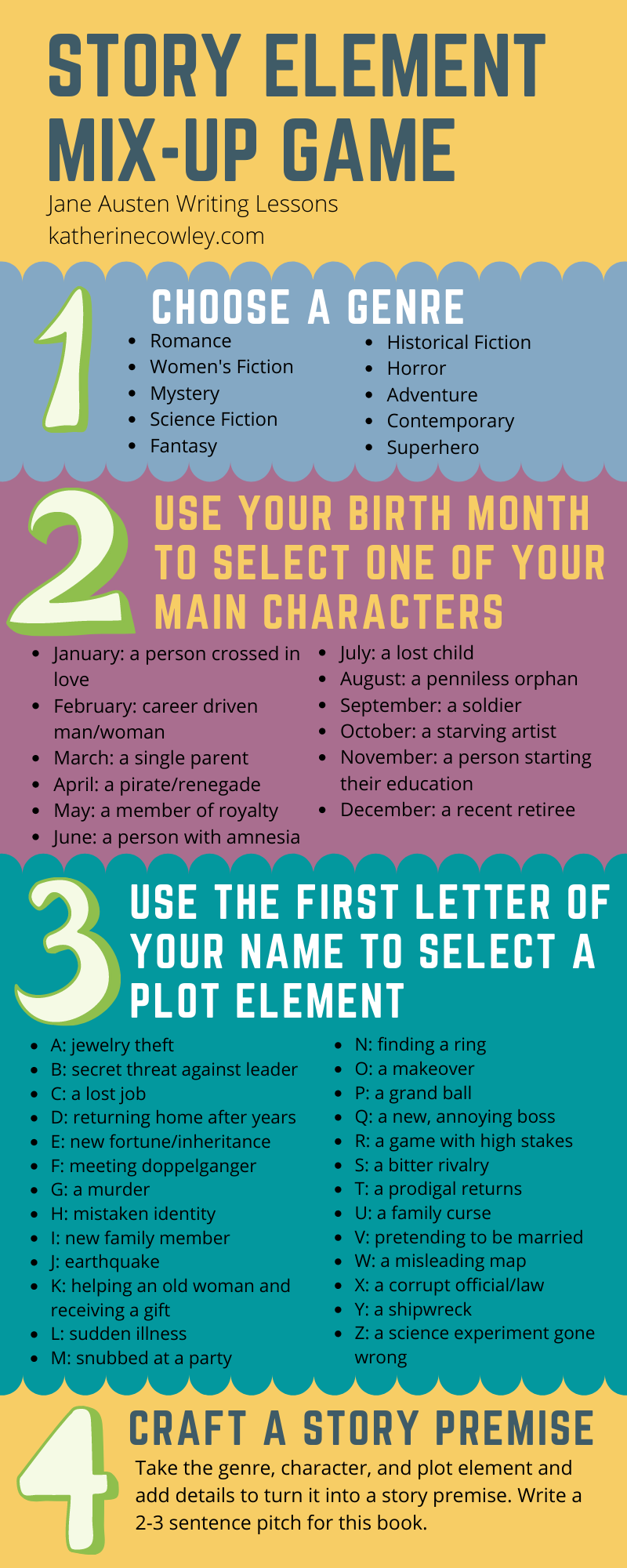#7: Create Multiple Relationship Arcs to Show Your Character’s Journey in Relation to Those Around Them
Theatrical adaptations of Jane Austen’s novels often eliminate characters in order to shorten, to focus, and/or to interpret the story. Simon Reade’s play Pride and Prejudice eliminates Colonel Fitzwilliam. Kate Hamill’s play Pride and Prejudice eliminates not only Colonel Fitzwilliam, but also Kitty and the Gardiners. Isobel McArthur’s play Pride and Prejudice (sort of) eliminates Colonel Fitzwilliam, but adds a group of named servants: Anne, Clara, Effie, Flo, Maisie, and Tillie. Melissa Leilani Larsen’s adaptation keeps Colonel Fitzwilliam (so if you’re a Colonel fan, this is the one for you); Mrs. Gardiner is maintained as a referenced character but is never seen on stage.
When characters are eliminated in an adaptation, either plot elements must be eliminated or something or someone else must step in to serve the missing role. For instance, in the adaptations that eliminate Colonel Fitzwilliam, Elizabeth must find out through other means that Mr. Darcy separated Jane and Mr. Bingley. (In one adaptation, Darcy himself tells her.)
The chosen cast of characters heavily influences the plot of any novel. Yet characters do more than that:
Each character can help illuminate the main character and their journey for the reader.
In Pride and Prejudice, the main character is Elizabeth Bennet, and the core relationship of the story is with Mr. Darcy, because it is through their relationship that we see most of Elizabeth’s change and growth through the story. Their relationship arc is a definitive component of Elizabeth’s journey.
Elizabeth also experiences relationship arcs with a number of other characters: her relationships with these people progress, develop, change, shift, deepen, weaken, experience betrayal, are challenged, etc.
Characters who have relationship arcs with Elizabeth in Pride and Prejudice:
- Jane
- Lydia
- Charlotte Lucas
- Wickham
- Bennet
- Bennet
- Collins
- Lady Catherine de Bourgh
- The Gardiners
There are a number of other characters in the novel whose relationships with Elizabeth don’t change or have an arc over the course of the novel, including:
- Mary
- Kitty
- Phillips
- Anne de Bourgh
- Sir William Lucas
- Lady Lucas
While not all characters need to have a relationship arc with the main character, incorporating multiple relationship arcs in a story makes a richer world and makes the main character seem more complex and nuanced. Relationship arcs show your main character’s journey in relation to those around them.
(Note: There are books with a single character, or just two or three characters, but most books include more. For those books with only a few characters, these relationship arcs tend to be especially important. In short stories it is typically better to only include a handful of characters.)
Exercise 1:
Make a list of people with whom you have interacted with in the last week, either in person or otherwise (phone call, letter, digitally, etc.). Put these people into categories (friends, family, work, school, mortal enemies, acquaintances, salespeople, etc.).
Draw a star next to the three people whose relationships with you have changed or developed the most within the last month or year.
Exercise 2:
Create a list of your favorite supporting characters from books or movies. These should not be main characters, but rather small or medium characters that play a part in the story. For each character you have listed, write down a few attributes that you like about them, as well as details about their relationship with the main character. If you’re willing, share one of these characters in the comments.
Exercise 3:
Option 1: If you are planning out a story, make a chart of character relationships that are important to your main character. This is a standard chart but can be adapted for the type of story you are telling (for example, a mystery novel should have a column titled “suspects”). Some categories may only include one person, while some categories may include a number of individuals.
It is likely that not all of these characters will be in your story, or at least not all of them will play crucial roles in the story. Some of these characters will be main characters, while others will be supporting. Underline the characters who will be most instrumental to the plot, and highlight the characters who will have the most important relationship arcs with the main character.
Option 2: If you are revising a story, use Excel, Google Spreadsheets, or paper and pen to chart your characters over the course of your novel. One way to do this is to put an “X” for every time they are seen in a chapter and an “x” for every time they are mentioned. Another way to do this is to write a brief description of the role each character plays in each chapter. Here’s a sample of what it might look like if I was tracking characters in the first few chapters of Pride and Prejudice.
Once you’ve completed your chart, you can use it to self-diagnose areas where you can improve. For example, if one of your characters is supposed to have an important relationship arc but they are not present for a six-chapter segment, that could be an important thing to incorporate in your revisions.
#6: Use a Character Arc to Make Your Character Change and Grow
The Jane Austen Society by Natalie Jenner is a beautiful new novel about how our favorite authors can save us. It made me cry approximately three times—fine, exactly three times—and is a fabulous read. In the novel, the first character we meet is the farmer Adam Berwick, a man broken by loss of family and dreams. The book begins with him in a death-like pose next to the Chawton cemetery, yet over the course of the first chapter he changes and grows.
Adam is challenged by a visitor to the town to read Jane Austen, and he reluctantly agrees. As he reads Pride and Prejudice, he begins to change:
Reading Jane Austen was making him identify with Darcy….It was helping him understand how even someone without much means or agency might demand to be treated. How we can act the fool and no one around us will necessarily clue us in.
He would surely never see the American woman again. But maybe reading Jane Austen could help him gain even a small degree of her contented state.
Maybe reading Austen could give him the key.
The external plot of the story is Adam and others coming together to save Jane Austen’s Chawton home. But each of the characters, including Adam, undergoes internal change and transformation over the course of the novel.
In a novel, the internal journey, or character arc, constantly intersects with the external journey. A character arc is not a straight line of progress. It includes failures and successes, embracing and resisting change. Ultimately though, our characters should learn and grow. (I have the same hope for my children. So far it’s working, except for the fact that my youngest has been coloring on walls for years.)
As you create a character arc, consider how this arc is influenced by:
All of Jane Austen’s completed novels contain excellently crafted character arcs: all of her main characters change, develop, and transform over the course of their stories.
One example of this is Catherine Morland in Northanger Abbey. In the introduction to the Broadview edition of Northanger Abbey, the scholar Claire Grogran writes about Catherine’s transformation: “Catherine becomes an adept reader not only of texts but also of people and of situations.”
An illustration of Catherine Morland reading.
This illustration, by an unknown artist, was included in the 1833 Bentley Edition of Jane Austen’s Novels.
At first, Catherine is innocent and naïve, which allows her to be manipulated by others, including her friend, Isabella Thorpe, and Isabella’s brother, John Thorpe. Even though John consistently interferes with her desires and other friendships, she does not see him for who she is.
The first time Catherine meets John Thorpe, she is “fearful of hazarding an opinion of [her] own in opposition to that of a self-assured man.” She finds herself constantly frustrated by Thorpe’s speech and behavior, yet she distrusts her own judgment, and does not read anything truly wrong into his character:
These manners did not please Catherine; but he was James’ friend and Isabella’s brother; and her judgment was further brought off by Isabella’s assuring her, when they withdrew to see the new hat, that John thought her the most charming girl in the world.
As their relationship progresses, Catherine consciously makes the decision to not read into his character, to ignore his flaws, and to allow him to override her plans. In this, she is resisting change and development. (Characters often resist change because change is hard.)
Little as Catherine was in the habit of judging for herself, and unfixed as her general notions of what men ought to be, she could not entirely repress a doubt, while she bore with the effusions of his endless conceit, of his being altogether completely agreeable.
Yet because of this, she misses the opportunity to spend time with her friend Miss Tilney, and her brother, Mr. Tilney, who she is romantically interested in. This leads her to conclude that “John Thorpe himself was quite disagreeable.”
A few chapters later, Catherine plans a walk with Miss Tilney, but it happens to be at the same time as an outing that John Thorpe wants Catherine to attend. Jealous and vindictive, Thorpe ignores Catherine’s wishes, goes to Miss Tilney, and cancels Catherine’s walk.
When Catherine learns of this, she takes action in a way that begins her path towards transformation and growth: she decides to trust her own judgement of the people and the situation, and to act decisively. Disregarding all of Isabella’s and John’s entreaties, she declares,
“This will not do. I cannot submit to this. I must run after Miss Tilney directly and set her right.”
Catherine then proceeds to do so. Throughout the rest of the novel, she gains more practice reading people and situations. Sometimes her judgment leads her false (as when Henry finds Catherine in his mother’s room, looking for clues of her supposed murder), but over the course of the novel she does improve in her ability to read situations and she allows this reading to inform and change her behavior.
Exercise 1:
Pick a name for a character, any name.
Now choose one of the following attributes:
- Courage
- Willingness to sacrifice for others
- Ambition
- Persistence
- Resourcefulness
- Thriftiness
- Ability to forgive others
Set a timer for ten minutes, and in that time make a list of the following four events which would create a basic character arc for this character:
- An event which shows that the character does not yet possess this attribute
- An event which shows the character learning this attribute
- An event which shows the character resisting or failing at the implementation of this attribute
- An event which shows that the character has learned to incorporate this attribute into their lives
Exercise 2:
Read a book or watch as movie, and as you do so, take notes on the main character. How do they change over the course of the story? What do they learn and how do they develop? How do they resist change? On a piece of paper, plot out the main points of their character arc. Visually, what type of line or arc would you draw to show their development?
Exercise 3:
Take a story of your own that you are currently writing or revising. Write a 2-3 sentence description of who the character must become by the end of the story. Then write a 2-3 sentence description of who the character is at the start of the story.
Now evaluate your character. A few things to consider:
- There needs to be enough distance between who the character is at the beginning of the story and who the character is at the end. In a novel, this distance will need to be much greater than in a short story.
- The character may have multiple things they need to learn.
- If your story is part of a series, the character needs to change or develop in new ways in each book.
- As the character develops and grows, the goal is not to make them a “perfect” character or eliminate all of the negative attributes that are a core part of their character.
- Often, more than one character has a character arc, and these arcs can intersect with each other, parallel each other, or interfere with each other.
#5: Make Things Hard for Your Character
In the film Austenland, the main character, Jane, goes shooting with the other guests at an Austen-themed resort. On the way back, her horse refuses to budge, so the others go on without her. She waits alone, and then begins walking back by herself. To make things worse, it begins to rain. Actually, pour.
Mr. Nobley comes to rescue Jane, but her troubles are not over: her skirt’s in the way (he helpfully rips it for her); when they get back, she has trouble getting off the horse and falls awkwardly over Mr. Nobley; finally, Lady Amelia Heartwright ignores Jane and then, once she notices her, she is appalled by her appearance.
The film is delightful and hilarious, in part because there is no end to Jane’s troubles. It’s not just horse trouble, or the rain, or the skirt—it’s obstacle building on obstacle, with small triumphs interspersed (she does, after all, manage to get off the horse).
I used to be afraid to hurt my characters, which greatly limited my stories. Challenge creates the potential for growth.
A great example of a character experiencing hard things is Anne Elliot in Persuasion. She is taking a long walk with a number of family members and friends, including her ex-fiancé Captain Wentworth (who still isn’t over the fact that she broke up with him a decade before), and his current love interest, Louisa Musgrove.
At one point, Anne decides to rest on the hill. Her location accidentally places her in a spot where she is forced to eavesdrop on Captain Wentworth and Louisa’s budding romance. This certainly qualifies as making things hard for your main character.
As we analyze this scene, we can see Austen implementing three different techniques that are used to make things difficult for characters:
- Provide external obstacles and challenges that require action and must be overcome
- Give the character successes or triumphs which lead to complications or other difficulties
- Use the character’s internal flaws or challenges to make it harder for the character to succeed
External Obstacles and Challenges
External obstacles can be created by other characters, nature, animals, society, technology—in other words, by anything outside of the character’s self.
Anne Elliot still loves Captain Wentworth, so in this scene the external challenge is caused by the romance between Captain Wentworth and Louisa, and by the fact that Anne is forced to witness it. At one point, Wentworth praises Louisa in a way that Anne knows is a direct critique of Anne’s own character and past choices:
“My first wish for all, whom I am interested in, is that they should be firm. If Louisa Musgrove would be beautiful and happy in her November of life, she will cherish all her present powers of mind.”
Anne does not take immediate action against this obstacle, but it is an obstacle that she must overcome over the course of the novel.
Successes or Triumphs
Seemingly good things—successes and triumphs—can also make things harder for the main character. This is counterintuitive because we expect good things to yield good results, yet good things can have a myriad of challenging results, including shallow victories, greater expectations/responsibilities, complicated relationships, and distractions from the real goal.
Not long after Anne eavesdrops on Wentworth and Louisa, the entire group reconvenes and begins the arduous journey home. Captain Wentworth goes out of his way to help Anne by securing her the only spot in a carriage for the ride home, and physically lifting her into the carriage, which could be considered a success or triumph for Anne. Yet this makes things more difficult for her:
This little circumstance seemed the completion of all that had gone before. She understood him. He could not forgive her, — but he could not be unfeeling. Though condemning her for the past, and considering it with high and unjust resentment, though perfectly careless of her, and though becoming attached to another, still he could not see her suffer, without the desire of giving her relief….[It] was a proof of his own warm and amiable heart, which she could not contemplate without emotions so compounded of pleasure and pain, that she knew not which prevailed.
The novel Persuasion provides many examples of how successes and triumphs can lead to further complications or other difficulties for the main character.
Internal Flaws and Challenges
Internal flaws and challenges also make it harder for characters to succeed at their goals.
During the first half of the novel, Anne’s internal flaws dominate: she still loves Captain Wentworth, but she is not assertive, and she does not make any clear attempts to show her affection to him.
Throughout this scene, Anne places herself and her desires beneath those of others, and she goes out of the way to avoid moments of interaction with Captain Wentworth. Despite her love, she intentionally avoids opportunities which could lead to them rekindling their friendship and romance:
Anne’s object was, not to be in the way of any body, and where the narrow paths across the fields made many separations necessary, to keep with her brother and sister.
Internal flaws and challenges are often harder for characters to overcome than any external obstacles.
In Conclusion
Making things hard for your character creates tension and conflict. It also makes the ultimate triumph of the character more compelling, because of all that they have had to overcome in the process.
In crafting hard things, it is important to avoid making the hard things too big or irrelevant. This scene with Anne Elliot and Captain Wentworth doesn’t need an earthquake or an angry villain to make things harder for Anne, because in this scene, these little challenges are emotionally relevant. Austen doesn’t shy away from big events and challenges—for example, Louisa’s terrible fall later in the book—but building to these larger events with other smaller challenges makes them more emotionally resonant.
Exercise #1: Consider what external challenges a character might face when purchasing vegetables. Make a list of at least two large challenges, two medium challenges, and two small challenges they could face. Now choose a few of these challenges and write a paragraph about this character purchasing vegetables. If you would like, share this paragraph in the comments.
Exercise #2: Make a list of some of your own characteristics that might be considered flaws (being prone to anger, perfectionism, etc.). Write a paragraph about a time in your life when one of these characteristics made doing something more difficult for you.
Exercise #3: Take a scene that you have written. Underline or circle all the things that are hard for your character, and label each of the things as an external obstacle/challenge, a success/triumph which leads to other difficulties, or an internal flaw/challenge. Now read through the scene again and consider whether or not you need to add more challenges, big or small.
#4: Create an External Journey for Your Character
Once your character wants something and there is an inciting incident that starts them on their journey, then the next step is to take them on that journey. Fortunately, we have a long tradition of studying how story works. Over two thousand years ago, Aristotle wrote about dramatic structure in The Poetics. For something to be a story, he explained, there must be a beginning, a middle, and an end. This movement through the beginning, middle, and end of a story typically takes the form of a complication followed by an unravelling.
Fast forward several thousand years to Gustav Freytag, who was a German playwright and novelist. He built on Aristotle’s sense of complication and unravelling, or rising and falling action, in a book titled Die Technik des Dramas (which in English is translated as Freytag’s Technique of the Drama). While there are many other theorists and writers who have presented useful models that explain how plot works (there are three act structures, four act structures, seven point structures, and Campbell’s hero’s journey, to name a few), we’re going to stick with a modified Freytag’s Pyramid for this lesson.
Understanding how the pyramid works can help you if you’re planning a novel. It is also useful during the revision process, because it can help you hit the key aspects of a story that readers expect and love. As an example, we’re going to analyze the plot structure of Pride and Prejudice.
The Exposition
The exposition is the story world in stasis, or as it existed before the inciting incident. For some books, this takes several chapters, for others, a few sentences, and for other stories, we start with the inciting incident and the exposition is delivered through little pieces of interspersed backstory.
In Pride and Prejudice, not much time is spent on exposition at all—news of the inciting incident is delivered on the very first page. Yet the backstory is made clear nonetheless: we understand who these characters are, we quickly grasp the nature of Mr. and Mrs. Bennet’s marriage, learn of the entailment, and understand Mrs. Bennet’s goal: to marry off her daughters so they don’t die in poverty.
The Inciting Incident
I wrote extensively about inciting incidents in lesson #3, but to recap, an inciting incident is what sets the plot in motion, changing things for the character and starting them on both their internal and external journey.
In Pride and Prejudice, the inciting incident is Mr. Bingley’s arrival. Mrs. Bennet sets her sights on him marrying her eldest daughter, Jane, which becomes one of the major threads of the novel. Mr. Bingley also brings with him his sisters and his good friend Mr. Darcy. Mr. Darcy quickly becomes antagonistic to our protagonist, Elizabeth, and it is these two characters, their pride and their prejudice, and of course, their romance, that creates the main journey of the novel.
Rising Action Part 1
After the inciting incident comes the rising action of the novel. To use Aristotle’s term, this is the “complication.” This is the middle, with all the interesting scenes and incidents and relationships that help and hinder the characters.
In the first half of this rising action, we get some of the most memorable scenes of Pride and Prejudice: two balls, the introduction of Mr. George Wickham, Mr. Collins and his terrible proposal, and Elizabeth’s trip to Rosings. Elizabeth and Mr. Darcy’s relationship changes and develops, circumstances change for many of the other characters, and the themes of the novel are explored and developed.
The Midpoint
Freytag doesn’t talk about the midpoint in his model, but many of the other structures do, because it’s a very powerful turning point that is used in a majority of stories.
The midpoint is an event in which the core aspects of the character’s journey are brought under a lens. The character typically experiences either a major victory, or a major defeat. This moment will provide the tools the main character needs to make it through the climax and falling action—if she chooses to use them.
The midpoint in Pride and Prejudice is Mr. Darcy’s first proposal to Elizabeth. Both Mr. Darcy and Elizabeth display their pride and prejudice in full force. Mr. Darcy tells Elizabeth all the many reasons he has resisted proposing to her (her family, their lack of connections, and their behavior). Elizabeth refuses him. She verbally attacks him for his pride, and she accuses him of splitting up Mr. Bingley and Jane and of ruining Mr. Wickham’s life forever (a falsehood, which shows the pitfalls of Elizabeth’s prejudice).
This moment marks a major shift for the characters, a moment where they begin to change both internally and externally. (Later, Mr. Darcy explains, “I have been a selfish being all my life, in practice, though not in principle. As a child I was taught what was right, but I was not taught to correct my temper. I was given good principles, but left to follow them in pride and conceit.”) After Elizabeth’s refusal, Mr. Darcy begins to treat others with more kindness; Elizabeth begins to question her preconceived notions and opens herself up to forgiveness and new perspectives.
There are several Pride and Prejudice adaptations that structurally move Darcy’s first proposal to the climax location of the story, which often leads to substantive plot and character changes, because then everything after that is falling action. (An example of this is Kate Hamill’s play adaptation of Pride and Prejudice.) However, in the original text, Mr. Darcy’s first proposal happens almost exactly at the midpoint of the novel, and many film adaptations follow suit (for instance, in the 1995 BBC adaptation, the proposal happens at the very end of the third episode, with three episodes remaining for the rest of the rising action, the falling action, and the denouement).
Rising Action Part 2
After the midpoint, we have more rising action, but as Blake Snyder explains in the screenwriting book Save the Cat, it’s not just fun and games anymore. The stakes are higher and more personal for the characters.
Darcy writes a letter explaining his story to Elizabeth, and Elizabeth reads it and realizes how very wrong she has been. The novel contains several chapters of reflection and soul-searching on her part. Elizabeth returns to her home and makes the decision not to expose Wickham’s true character. She then takes a trip to Derbyshire with her aunt and uncle, and while there they visit Darcy’s home, Pemberley, thinking he is not home. Darcy’s servants testify of his true character, and then Darcy appears. He has changed—he goes out of his way to be friendly and polite to Elizabeth’s aunt and uncle.
The Climax
The climax is the point where all the themes and conflicts of the novel come to a crisis, and where it seems impossible for the characters to get what they want.
In Pride and Prejudice, the climax is when Elizabeth receives Jane’s letter and finds out that her youngest sister, Lydia, has ran off with Mr. Wickham. This truly is a crisis: the whole family will likely be ruined when word of this gets out, and Elizabeth will have no chance of a good marriage. Further, she believes that now Mr. Darcy must despise her—everything he disliked about her family before pales in comparison to this. Mr. Darcy immediately leaves, and Elizabeth is certain that she will never see him again.
Falling Action
The falling action, or what Aristotle called the unravelling, is when all the final problems are addressed. Now the characters are really put to the test: will they be able to use what they learned from the midpoint to conquer the crisis?
In some genres, this would be the big final battle; a Jane Austen story may not have an actual battle, but the stakes are just as high, and the circumstances challenge the characters to their limits.
In Pride and Prejudice, Darcy proves himself in the falling action by finding Lydia and Wickham, forcing them to marry, and providing them with financial support—all without taking any credit for it.
Elizabeth goes home and provides endless support for her family members. Then, when Lady Catherine de Bourgh visits in an attempt to intimidate Elizabeth into submission (and into promising never to enter into an engagement with Mr. Darcy), Elizabeth uses her pride in a useful way, to defend herself and stick to her principles. This event ultimately leads Darcy to realize that he still has a chance with Elizabeth.
The last test of their characters is if Elizabeth and Darcy can let go of their pride one last time and be fully reconciled to each other.
Resolution and Denouement
The resolution of the plot is the final event or moment that resolves or solves the final, major questions that have been raised. The denouement ties up loose ends, and the main characters end up better off than they were at the start of the novel.
Elizabeth and Darcy are able to converse earnestly and deeply, and Darcy proposes. This proposal, and Elizabeth’s acceptance, contrasts strongly with the original proposal: they have let go of their prejudices and made themselves vulnerable to each other.
The denouement consists of two sets of marriages: Jane to Bingley, and Elizabeth to Darcy. Other minor things are wrapped up: Kitty, we find, becomes “less irritable, less ignorant, and less insipid.” Lady Catherine is “indignant,” but ultimately “[condescends] to wait on them at Pemberley.”
On Tragedy
In the Aristotelian tradition, there are only two genres: tragedy and comedy. Anything that is not tragedy is a comedy using this model. Sarah Emsley has made the argument that Austen’s Mansfield Park is a tragedy rather than a comedy, something that will be discussed in more detail in a future lesson.
In a tragedy, the climax is often a high point rather than a crisis. The main character does not learn the lessons they needed to learn: their character does not shift and grow, which leads, in the falling action, to their literal fall. In the denouement, we see their ruin: the main character is worse off than they were at the beginning of the story.
In Sum
The rising action, the sense of building, engages the reader. We become more and more invested in the story, and as a result, the falling action leaves us feeling satisfied. The characters’ internal journeys and growth are interwoven with the main points of the plot structure.
As a disclaimer, many short stories and some novels do not use this structure. Yet even though this plot structure is not universally used, it’s a useful construct that helps us understand what readers expect from stories and an approach that typically is effective at creating an external journey for the main character.
Exercise 1:
Reread one of your favorite books or rewatch one of your favorite films, this time paying attention to structure. Plot the major events on a Freytag Pyramid, and, if possible, include the page number or number of minutes into the film where these events occur within the story. (This is an exercise I have done a number of times, and it’s a really useful way to internalize plot structure.)
Exercise 2:
Take something that happened during your day, some sort of incident, positive or negative. This could be an interaction at work, the process of cooking something, a conversation with a child, etc. Write this as a short story (maximum three paragraphs) with a beginning, middle, and end. Make sure to include an inciting incident, rising action, a midpoint, some sort of crisis, and then falling action/resolution. Then go back and label the parts by adding brackets with descriptions such as [Inciting Incident]. If you’d like, share the story in the comments!
Exercise 3:
Option 1: Outline a story idea using Freytag’s pyramid. You don’t need to include all the elements of the story, but make sure to include the key details.
Option 2: If you prefer discovery writing to outlining, brainstorm the elements you would like both the climax and falling action to include (i.e. something very romantic, a big twist, something action packed, etc.).
Option 3: If you already have a full draft of a novel, use Freytag’s pyramid as a revision tool. Write the major plot points you’ve included on the pyramid, and list the page numbers where these events occur in your manuscript. To take it up a notch, write down the character’s emotions and/or internal struggle at each of these key events.
Now analyze your pyramid:
- Are there any events that would be more effective if moved to a different part of the pyramid?
- Does the main character face enough struggle?
- At the crisis, have you successfully put the main character in a spot where it seems impossible for them to succeed?
- Does the main character use what they have learned during the rising action to solve their problems during the falling action?
#3: Use an Inciting Incident to Set the Plot in Motion
One of my all-time favorite films is Austenland. It’s a comedy about a woman named Jane who spends her savings to stay at an all-inclusive, Jane Austen-themed resort. At one point in the film, she and another character, Mr. Nobley, find themselves running.
Mr. Nobley asks, “Why are we running?”
Jane replies, “Because a man and a woman should never be alone unless they are in motion.”
Just like characters in the Regency period (or anyone in an immersive Jane Austen experience), stories themselves should not be at rest.
Stories are generally about motion, they are about change and development, both in terms of character and plot. Yet as humans, we are stationary beings. We do what we have been doing: we stay still, or, if we have a path, we stick to that path unless something changes.
An inciting incident is an event that carries weight for the main character and creates the opportunity for change, both internally and externally. An inciting incident often introduces forces outside of the main character’s control, and is a disruption that requires the main character to adapt and grow and interact with others in new ways. An inciting incident often relates, in some way, to the main themes or conflicts of the novel.
1884 cover of Sense and Sensibility, from the British Library
In Sense and Sensibility, Mr. Dashwood’s death changes everything for Mrs. Dashwood and her daughters, Elinor, Marianne, and Margaret. Yet for a time, they stay in stasis, continuing to live on the estate that has been their home. Yet it is no longer really their home: Mrs. Dashwood’s stepson, Mr. John Dashwood, and his wife, Fanny Dashwood, are the new owners. Fanny in particular makes the elder Mrs. Dashwood and her daughters unwelcome, especially once she notices that her brother, Edward Ferrars, is interested in Elinor. She rudely confronts Mrs. Dashwood on the subject, and Mrs. Dashwood decides that they will withdraw from the estate:
To quit the neighborhood of Norland was no longer an evil; it was an object of desire; it was a blessing, in comparison of the misery of continuing her daughter-in-law’s guest: and to remove for ever from that beloved place would be less painful than to inhabit or visit it while such a woman was its mistress.
As they leave, Marianne wails a lament:
“Dear, dear Norland! when shall I cease to regret you!—when learn to feel a home elsewhere!—Oh! happy house, could you know what I suffer in now viewing you from this spot, from whence perhaps I may view you no more!….you will remain the same; unconscious of the pleasure or the regret you occasion, and insensible of any change in those who walk under your shade!—But who will remain to enjoy you?”
This forced eviction takes the Dashwoods on a physical journey—to a new county, where they live in a cottage and meet a whole set of new people. In addition to a physical journey, it’s also a journey to try to find home and to see if they can survive losing almost everything that they find dear. This journey starts both Marianne and Elinor on internal journeys; Marianne is full of sensibility and unrestrained emotion, but must learn how to let more than her emotions govern her; Elinor has a bit too much sense, and keeps too much inside her, not allowing herself to want and hope for the things she really desires.
While some inciting incidents lead to physical journeys, like in Sense and Sensibility, a physical journey is not required. For instance, in Emma the inciting incident is the marriage of Emma’s governess. Emma’s internal and external journeys are captivating, but they do not require her to leave her home (the furthest she goes is Box Hill, which is only seven miles away).
Change is at the heart of interesting plots, and the possibility for change is why we root for characters. A good inciting incident sets the plot in motion and paves the way for the rest of the story.
Exercise 1: Choose one of your favorite books or movies. What is the inciting incident? How does this event change things for the main character and start them on a journey? Share your thoughts in the comments.
Exercise 2: In the following paragraph, a character is pursuing something she wants: the opportunity to be the pianist for the high school musical. Add an inciting incident, something that will disrupt and change things for Luciana. For the purposes of this exercise, keep it short—anywhere from a sentence to a full paragraph. Once you’ve written the inciting incident, consider how it would change the character’s trajectory and what sort of story might result from it.
Luciana ran her fingers up and down the keys of an imaginary piano. She had been preparing for this audition for months, and now the time had finally come. She closed the book and looked at her hands. They were warm, they were flexible, and they were ready. She would be chosen as the accompanist for the high school musical this year, surely. She waited impatiently for her turn on the grand piano, but she need not have worried. Luciana played the music flawlessly, and the music director gave her an assuring smile as she left the room.
Exercise 3: Take a new story idea, one that you haven’t yet developed. Spend a few minutes brainstorming an inciting incident, or, if you prefer discovery writing, write an opening scene and see what inciting incident will put your character in motion or change her direction.
#2: Combine Multiple Elements to Create an Engaging Premise
There’s a popular Studio C comedy skit called “Teddy’s Story Joint.” In it, authors go to a story restaurant and buy their plots. The first author to visit is Jane Austen, who says, “I’d like a plot today. The usual.”
A new employee asks her boss, “What’s the usual?”
He explains what Jane Austen is looking for: “Girl likes a guy. Looks like she won’t get the guy, but then she does.” He turns to Jane Austen and asks, “With the witty social critique on the side?”
Jane Austen smiles and says, “You know how I like it.”
Arguably, there might only be seven basic plots, but obviously there’s a lot more to Jane Austen than this very basic plot structure found at the core of her novels. How do you do this in your own writing: how can you make your stories different from all the other stories out there?
While almost every idea has been “done before” in some way or another, if you’re brainstorming or developing a concept it’s useful to combine multiple elements to create an engaging and original premise.
Take Jane Austen’s Persuasion as an example. Yes, it’s a love story with hiccups—but it’s so much more than that.
Here are some of the key elements that together make it a fascinating premise:
The two penguins fighting over Wentworth’s heart are Louisa and Henrietta Musgrove. Anne Elliot is the penguin on the top left, trying hard to not watch. (Penguins from the California Academy of Sciences.)
Persuasion incorporates lost love, jealousy, longing, misunderstandings, the pain of betrayal, and family conflict. It’s an engaging concept, even when written in bullet point form. The elements are distinctive and focused, they can be explained quickly and easily, and they paint a picture of the character, plot, and conflict.
How do you create an engaging premise or concept?
Take the kernel of your story idea—whether it’s a character, a plot idea, a situation, a setting—and start combining it with other things. Consider what happens if you put the story in a different time, use a different genre, or add a different subplot. What happens if you change a key detail about one of the characters? Once you start getting excited about the concept, then you know you have something worth writing.
Exercise 1:
Play the story element mix-up game below. First, choose a genre, then select a main character and a plot element. Add details and craft a pitch for the story’s premise.
As an example, I have selected the following elements:
- Historical fiction
- Person crossed in love
- Helping an old woman and receiving a gift
Now I will add some additional details in order to craft a story premise:
The widow Lady Gertrude thought she had found love again, but the charming Mr. Wenton was actually a swindler who robbed her of 1000 pounds. Now she is fighting to keep her deceased husband’s estate, while struggling to help the ailing, old housekeeper, Mrs. Winter. Lady Gertrude cares for Mrs. Winter personally, and with her dying breaths Mrs. Winter tells her the location of hidden chest. Inside, Lady Gertrude discovers a family secret: a record of her deceased husband’s disinherited cousin, the scarred and troubled Colonel Anthrop, who may hold the key to saving both the estate and Lady Gertrude’s broken heart.
If you would like to do the exercise more than once, use the birth month and name of a friend, or change the genre. (Or go rogue and choose whichever elements from the chart you would like!)
If I were to create a story premise with the same components but a different genre (superhero), my story premise might look like this:
Angela moves to a small town in the upper peninsula of Michigan to escape her past—and her cheating ex-boyfriend. As she’s moving into an old, one-bedroom apartment, she helps an old woman with her groceries. The brownies the old woman gives her as a thank-you give Angela superpowers, including the ability to sense when a crime is being committed. Soon she discovers a conspiracy involving the famous Tahquamenon Falls, and Angela must use her powers to save her newfound community.
Exercise 2
Brainstorm a list of story ideas. These do not have to be fully developed story ideas—rather, they can be interesting story elements. The film director Michael Rabiger recommends keeping a CLOSAT journal, where you record interesting Characters, Locations, Objects, Situations, Acts, and Themes. These can be from life, from your imagination, from other stories or art, from the news, etc. Once you find a story element you really like, see what you can combine it with to develop a story.
Exercise 3
If you are already working on a short story or a novel, practice writing an elevator pitch: a short, 1-2 sentence pitch about your story that you could give to someone in the length of time you would spend with them in an elevator. Consider which core elements make your premise unique and compelling, and see if you can capture the core conflict of the story in your pitch. As a bonus challenge, pitch your story idea to five different people.


